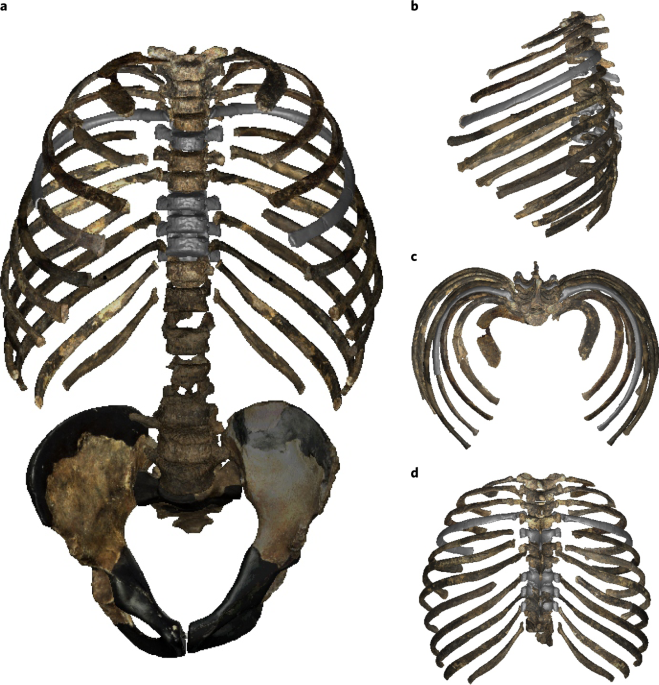
Walker, A. & Leakey, R. in The Nariokotome Homo erectus Skeleton (eds Walker, A. & Leakey, R.) 95–160 (Harvard Univ. Press, 1993).
Ruff, C. & Walker, A. in The Nariokotome Homo erectus Skeleton (eds Walker, A. & Leakey, R.) 234–265 (Harvard Univ. Press, 1993).
Jellema, L. M., Latimer, B. & Walker, A. in The Nariokotome Homo erectus Skeleton (eds Walker, A. & Leakey, R.) 294–325 (Harvard Univ. Press, 1993).
Holliday, T. W. Body size, body shape, and the circumscription of the genus Homo. Curr. Anthropol. 53, S330–S345 (2012).
Antón, S. C., Leonard, W. R. & Robertson, M. L. An ecomorphological model of the initial hominid dispersal from Africa. J. Hum. Evol. 43, 773–785 (2002).
Bramble, D. M. & Lieberman, D. E. Endurance running and the evolution of Homo. Nature 432, 345–352 (2004).
Pontzer, H. Economy and endurance in human evolution. Curr. Biol. 27, R613–R621 (2017).
Carrier, D. R. et al. The energetic paradox of human running and hominid evolution [and Comments and Reply]. Curr. Anthropol. 25, 483–495 (1984).
Lordkipanidze, D. et al. Postcranial evidence from early Homo from Dmanisi, Georgia. Nature 449, 305–310 (2007).
Braun, D. R. et al. Oldowan behavior and raw material transport: perspectives from the Kanjera Formation. J. Archaeol. Sci. 35, 2329–2345 (2008).
Arsuaga, J. L. et al. A complete human pelvis from the middle Pleistocene of Spain. Nature 399, 255–258 (1999).
Simpson, S. W. et al. A female Homo erectus pelvis from Gona, Ethiopia. Science 322, 1089–1092 (2008).
Rosenberg, K. R., Zuné, L. & Ruff, C. B. Body size, body proportions, and encephalization in a Middle Pleistocene archaic human from northern China. Proc. Natl Acad. Sci. USA 103, 3552–3556 (2006).
Bonmatí, A. et al. Middle Pleistocene lower back and pelvis from an aged human individual from the Sima de los Huesos site, Spain. Proc. Natl Acad. Sci. USA 107, 18386–18391 (2010).
Arsuaga, J. L. et al. Postcranial morphology of the Middle Pleistocene humans from Sima de los Huesos, Spain. Proc. Natl Acad. Sci. USA 112, 11524–11529 (2015).
Franciscus, R. G. & Churchill, S. E. The costal skeleton of Shanidar 3 and a reappraisal of Neandertal thoracic morphology. J. Hum. Evol. 42, 303–356 (2002).
Gómez-Olivencia, A., Eaves-Johnson, K. L., Franciscus, R. G., Carretero, J. M. & Arsuaga, J. L. Kebara 2: new insights regarding the most complete Neandertal thorax. J. Hum. Evol. 57, 75–90 (2009).
Gómez-Olivencia, A. et al. 3D virtual reconstruction of the Kebara 2 Neandertal thorax. Nat. Comm. 9, 4387 (2018).
Ohman, J. C. et al. Stature at death of KNM-WT 15000. J. Hum. Evol. 17, 129–142 (2002).
Graves, R. R., Lupo, A. C., McCarthy, R. C., Wescott, D. J. & Cunningham, D. L. Just how strapping was KNM-WT 15000? J. Hum. Evol. 59, 542–554 (2010).
Ruff, C. B. & Burgess, M. L. How much more would KNM-WT 15000 have grown? J. Hum. Evol. 80, 74–82 (2015).
Antón, S., Potts, R. & Aiello, L. Human evolution. Evolution of early Homo: an integrated biological perspective. Science 345, 1236828 (2014).
Torres-Tamayo, N. et al. The torso integration hypothesis revisited in Homo sapiens: contributions to the understanding of hominin body shape evolution. Am. J. Phys. Anthropol. 167, 777–790 (2018).
Williams, S. A. et al. The vertebrae and ribs of Homo naledi. J. Hum. Evol. 104, 136–154 (2017).
Latimer, B., Lovejoy, C. O., Spurlock, L. & Haile-Selassie, Y. in The Postcranial Anatomy of Australopithecus afarensis: New Insights from KSD-VP-1/1 (eds Haile-Selassie, Y. & Su, D. F.) 143–153 (Springer, 2016).
Schmid, P. et al. Mosaic morphology in the thorax of Australopithecus sediba. Science 340, 1234598 (2013).
Bastir, M. et al. 3D geometric morphometrics of thorax variation and allometry in Hominoidea. J. Hum. Evol. 113, 10–23 (2017).
De Troyer, A., Kirkwood, P. A. & Wilson, T. A. Respiratory action of the intercostal muscles. Phys. Rev. 85, 717–756 (2005).
García-Martínez, D. et al. Over 100 years of Krapina: new insights into the Neanderthal thorax from the study of rib cross-sectional morphology. J. Hum. Evol. 122, 124–132 (2018).
Openshaw, P., Edwards, S. & Helms, P. Changes in rib cage geometry during childhood. Thorax 39, 624–627 (1984).
LoMauro, A. & Aliverti, A. Sex differences in respiratory function. Breathe 14, 131–140 (2018).
Bastir, M. et al. In vivo 3D analysis of thoracic kinematics: changes in size and shape during breathing and their implications for respiratory function in recent humans and fossil hominins. Anat. Rec. 300, 255–264 (2017).
Callison, W. É., Holowka, N. B. & Lieberman, D. E. Thoracic adaptations for ventilation during locomotion in humans and other mammals. J. Exp. Biol. 222, jeb189357 (2019).
Latimer, B. & Ward, C. V. in The Nariokotome Homo erectus Skeleton (eds Walker, A. & Leakey, R.) 266–293 (Harvard Univ. Press, 1993).
Haeusler, M., Schiess, R. & Boeni, T. New vertebral and rib material point to modern bauplan of the Nariokotome Homo erectus skeleton. J. Hum. Evol. 61, 575–582 (2011).
Bastir, M. et al. Differential growth and development of the upper and lower human thorax. PLoS ONE 8, e75128 (2013).
Haeusler, M. et al. Morphology, pathology, and the vertebral posture of the La Chapelle-aux-Saints Neandertal. Proc. Natl Acad. Sci. USA 116, 4923–4927 (2019).
Schiess, R. & Haeusler, M. No skeletal dysplasia in the Nariokotome boy KNM-WT 15000 (Homo erectus)—a reassessment of congenital pathologies of the vertebral column. Am. J. Phys. Anthropol. 150, 365–374 (2013).
Warrener, A. G., Lewton, K. L., Pontzer, H. & Lieberman, D. E. A wider pelvis does not increase locomotor cost in humans, with implications for the evolution of childbirth. PLoS ONE 10, e0118903 (2015).
Beyer, B. et al. In vivo thorax 3D modelling from costovertebral joint complex kinematics. Clin. Biomech. 29, 434–438 (2014).
Beyer, B. et al. Effect of anatomical landmark perturbation on mean helical axis parameters of in vivo upper costovertebral joints. J. Biomech. 48, 534–538 (2015).
De Troyer, A., Kelly, S., Macklem, P. T. & Zin, W. A. Mechanics of intercostal space and actions of external and internal intercostal muscles. J. Clin. Invest. 75, 850–857 (1985).
Wilson, T. A. & De Troyer, A. The two mechanisms of intercostal muscle action on the lung. J. Appl Physiol. 96, 483–488 (2004).
Gehr, P. et al. Design of the mammalian respiratory system. V. Scaling morphometric pulmonary diffusing capacity to body mass: wild and domestic mammals. Respir. Physiol. 44, 61–86 (1981).
Stahl, W. R. Scaling of respiratory variables in mammals. J. Appl. Physiol. 22, 453–460 (1967).
Jones, R. L. & Nzekwu, M. M. U. The effects of body mass index on lung volumes. Chest 130, 827–833 (2006).
Ruff, C. Body size and body shape in early hominins – implications of the Gona Pelvis. J. Hum. Evol. 58, 166–178 (2010).
Ruff, C. B., Burgess, M. L., Squyres, N., Junno, J. A. & Trinkaus, E. Lower limb articular scaling and body mass estimation in Pliocene and Pleistocene hominins. J. Hum. Evol. 115, 85–111 (2018).
Raichlen, D. A., Armstrong, H. & Lieberman, D. E. Calcaneus length determines running economy: implications for endurance running performance in modern humans and Neandertals. J. Hum. Evol. 60, 299–308 (2011).
Schmidt-Nielsen, K. Desert Animals: Physiological Problems of Heat and Water (Clarendon Press, 1964)
Hora, M., Pontzer, H., Wall-Scheffler, C. M. & Sládek, V. Dehydration and persistence hunting in Homo erectus. J. Hum. Evol. 138, 102682 (2020).
Stewart, J. R. et al. Palaeoecological and genetic evidence for Neanderthal power locomotion as an adaptation to a woodland environment. Quat. Sci. Rev. 217, 310–315 (2019).
Ahmetov, I. I., Egorova, E. S., Gabdrakhmanova, L. J. & Fedotovskaya, O. N. Genes and athletic performance: an update. Genet. Sports 61, 41–54 (2016).
García-Martínez, D. et al. Ribcage measurements indicate greater lung capacity in Neanderthals and Lower Pleistocene hominins compared to modern humans. Commun. Biol. 1, 117 (2018).
Churchill, S. E. in Neanderthals Revisited (eds Harvati, K. & Harrison, T.) 113–156 (Springer Verlag, 2006).
Churchill, S. E. Thin on the Ground: Neandertal Biology, Archeology and Ecology (Wiley Blackwell, 2014).
Lieberman, D. E., Bramble, D. M., Raichlen, D. A. & Shea, J. J. in The First Humans: Origin and Early Evolution of the Genus Homo (eds Grine, F. E. et al.) 77–92 (Springer, 2009).
García-Martínez, D., Riesco, A. & Bastir, M. in Geometric Morphometrics Trends in Biology, Paleobiology and Archaeology (eds Carme Rissech, L. L. et al.) 93–97 (Seminari d’Estudis i Recerques Preshistoriques, Universitat de Barcelona, Societat Catalana d’Arqueologia, 2018).
Mitteroecker, P. & Gunz, P. Advances in geometric morphometrics. J. Evol. Biol. 36, 235–247 (2009).
Gunz, P. & Mitteroecker, P. Semilandmarks: a method for quantifying curves and surfaces. Hystrix 24, 103–109 (2013).
García-Martínez, D. et al. 3D growth changes in ribs during late ontogeny in hominids and its importance for the thorax of KNM-WT 15000: a preliminary approach. Proc. Eur. Soc. Study Hum. Evol. 6, 72 (2017).
Bastir, M., García-Martínez, D., Spoor, F. & Williams, S. A. Thoracic vertebral morphology of KNM-WT 15000. Proc. Eur. Soc. Study Hum. Evol. 8, 11 (2018).
Bastir, M. et al. Workflows in a virtual morphology lab: 3D scanning, measuring, and printing. J. Anthropol. Sci. 97, 1–28 (2019).
Mallison, H. The digital Plateosaurus II: an assessment of the range of motion of the limbs and vertebral column and of previous reconstructions using a digital skeletal mount. Acta Paleontol. Pol. 55, 433–458 (2010).
Been, E., Gómez-Olivencia, A., Kramer, P. A. & Barash, A. in Human Paleontology and Prehistory (eds Marom, A. & Hovers, E.) 239–251 (Springer Verlag, 2017).
Bastir, M. et al. in The Human Spine (eds Been, E., Gómez-Olivencia, A. & Kramer, P.) 361–386 (Springer Verlag, 2019).
Fletcher, J., Stringer, M., Briggs, C., Davies, T. & Woodley, S. CT morphometry of adult thoracic intervertebral discs. Eur. Spine J. 24, 2321–2329 (2015).
Goh, S., Price, R. I., Leedman, P. J. & Singer, K. P. The relative influence of vertebral body and intervertebral disc shape on thoracic kyphosis. Clin. Biomech. 14, 439–448 (1999).
Schiess, R., Boeni, T., Rühli, F. & Haeusler, M. Revisiting scoliosis in the KNM-WT 15000 Homo erectus skeleton. J. Hum. Evol. 67, 48–59 (2014).
Goodyear, M. D. E., Krleza-Jeric, K. & Lemmens, T. The Declaration of Helsinki. BMJ 335, 624–625 (2007).
Sokal, R. R. & Rohlf, F. J. Biometry 3rd edn (W. H. Freeman and Company, 1998).
Hackx, M. et al. Effect of total lung capacity, gender and height on CT airway measurements. Br. J. Radiol. 90, 20160898 (2017).
Stocks, J. & Quanjer, P. Reference values for residual volume, functional residual capacity and total lung capacity. ATS Workshop on Lung Volume Measurements. Official Statement of The European Respiratory Society. Eur. Resp. J. 8, 492–506 (1995).
Nagesh, K. R. & Pradeep Kumar, G. Estimation of stature from vertebral column length in South Indians. Leg. Med. 8, 269–272 (2006).
Sverzellati, N. et al. Computed tomography measurement of rib cage morphometry in emphysema. PLoS ONE 8, e68546 (2013).
Cassart, M., Gevenois, P. A. & Estenne, M. Rib cage dimensions in hyperinflated patients with severe chronic obstructive pulmonary disease. Am. J. Respir. 154, 800–805 (1996).
García-Martínez, D. et al. 3D analysis of sexual dimorphism in ribcage kinematics of modern humans. Am. J. Phys. Anthropol. 169, 348–355 (2019).
Beyer, B., Van Sint Jan, S., Chèze, L., Sholukha, V. & Feipel, V. Relationship between costovertebral joint kinematics and lung volume in supine humans. Respir. Physiol. Neurobiol. 232, 57–65 (2016).
Chapman, T. et al. How different are the Kebara 2 ribs to modern humans? J. Anthropol. Sci. 95, 183–201 (2017).
Van Sint, J. S. et al. Une plate-forme technologique liée à la paralysie cérébrale. Le projet ICT4Rehab. Med Sci. (Paris) 29, 529–536 (2013).
Hammer, Ø. PAST: Palaeontological Statistics, version 3.25 https://folk.uio.no/ohammer/past/past3manual.pdf (2019).
Klingenberg, C. P. & Marugán-Lobón, J. Evolutionary covariation in geometric morphometric data: analyzing integration, modularity and allometry in a phylogenetic context. Syst. Biol. 62, 591–610 (2013).
Source: Ecology - nature.com



